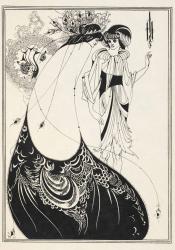Salome is Published
Salome was already in rehearsals for a 1892 London premiere, but was banned by the Lord Chamberlain's Office for its portrayal of BIblical figures on stage (these laws would not change for 40 more years). In 1893, however, the play was published in its original French. In regards to this language choice, Wilde is quoted as having said to an interviewer with the Pall Mall Gazette in 1892, "My idea of writing the play was simply this: I have one instrument that I know I can command, and that is the English language. There was another instrument to which I had listened all my life, and I wanted once to touch this new instrument to see whether I could make any beautiful thing out of it". Salome follows the step-daughter of King Herod (named Salome, if you couldn't guess) after she requests the head of John the Bapitist on a silver platter. The main focus of the play was a dance, performed by the actress who played Salome, in which they would dance with seven silk scarves. The sexuality of Wilde's version of Salome's dance differs greatly from that mentioned in the New Testament. An illustrated English translation of the play would be released in 1894, but Salome would remain illegal to produce in England until 1931. Aubrey Beardsley, a prominent aestheticist, did the illustrations for the 1894 edition. Beardsley's work in the Art Nouveau movement had made him a similarly controversial subject to Wilde, as his drawings were largely very graphic erotica.
Sources:
-Peter Raby, Introduction, p. xiii The Importance of Being Earnest and Other Plays, Oxford, Worlds Classics, 2008 ISBN 978-0-19-953597-2
-“The Censure and Salomé: An Interview with Mr Oscar Wilde,” Pall Mall Budget, 30 June 1892, p. 947.
-“Beardsley, Aubrey Vincent (1872–1898), Illustrator.” Oxford Dictionary of National Biography, www.oxforddnb.com/view/10.1093/ref:odnb/9780198614128.001.0001/odnb-9780....

